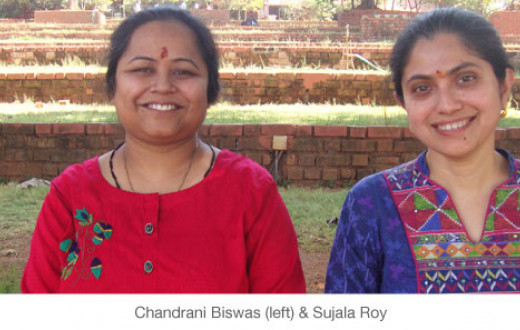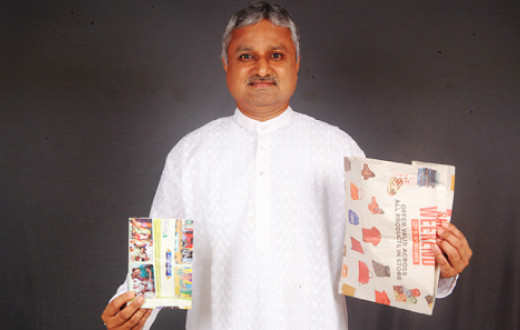
The journey of ex-corporate employees, Pradeep and Swetha in setting up an A2 milk company.
Looking at a herd of Hallikar cows graze on a forest patch quietly, you can fall into meditation without even closing your eyes. The only sound is that of the tinkling of the tiny bells around their necks. They appear still except for the slight movement they make as they graze steadily: neither too slow nor too fast. They dot the forest landscape uniformly, placing themselves neither too close to each other nor too far. They walk back home steadily, without hurrying, looking threatening with their sharp horns. Yet, their deep, soft eyes inevitably give themselves away.
It came like a revelation during a silence program. It came to Swetha as well. She told me as much on the last day. We were walking towards the ashram dining hall (The Art of Living International Center, Bengaluru) when we spotted a board about an agricultural initiative. She stopped in her tracks. Until then, she was not inclined to break her silence. Looking at the board, she said, “I want to do something in food, I felt this during silence,” she said. I looked at her incredulously. “I had the same thought!”
Six months later, there we were at a certified organic farm in rural Rajasthan, listening to a disgruntled farmer tell us that 100 percent organic produce was just not possible. “There are some bugs that spoil my crops. So I have to use some sulfur,” he said innocently. This was one of the farms of an organic grocery brand whose distributorship we had taken. Post our epiphany and several discussions, we had both quit our corporate jobs, much to the dismay of our families, to provide organic food to people. We started under the name ‘Swarg Foods’, a name fondly given by our mentor.
We naturally did not want to sell non-organic food under the organic garb. But what could we do? We had just left our jobs.
The holy cow to the rescue
A few months ago, I was a project lead at an MNC, toiling for 20 hours a day. 20 office hours became 10 after regularly practicing Sudarshan Kriya. With more time in hand, I started a small enterprise of setting up sound systems in events including those in The Art of Living programs. Like me, Swetha was a fellow Art of Living volunteer. We were both looking to do something more when the silence program happened.
After our interactions with ‘organic’ farmers, we tried to understand why they were not able to follow a 100 percent organic model. We found the missing link to be indigenous cows. The manure from these cows attracts earthworms of the local soil. Desi cow dung is also used to make pesticides and insecticides. Before the advent of chemical fertilizers, they played a significant role in Indian agriculture. However, the knowledge of their role in farming was lost over time.
To truly get 100 percent organic produce, indigenous cows needed attention. This was missing in the villages we went to. After a brief and failed partnership with someone in the business of indigenous cow milk, we were sure that we wanted to work with indigenous cows. A2 milk, the milk from indigenous cows is healthier and tastier than A1 milk, the milk from jersey cows. It can also help with digestive issues. We had heard this from customers during our earlier stint.
The day the partnership broke, Swetha drove to villages near her hometown in rural Karnataka. The idea was to source A2 milk. But the farmers she met did not care much about the indigenous cows in their village. ‘They’d rather sell these cows to the butcher than take care of them,’ Swetha told me over the phone. But knowing Swetha’s dogged determination, I knew change was coming.
‘Double the price of jersey cow milk’
‘Will you sell their milk for double the price of Jersey cow milk?’ we asked a farmer in Ambali, Karnataka. He laughed, nodding his head in disbelief that someone would be foolish enough to consider buying the milk of the Hallikars. ‘I don’t mind but their yield is just half a liter,” he said. ‘It is okay. We can help you increase their yield,’ I replied. ‘Without injections,’ Swetha added. The farmer’s amusement was replaced by curiosity. ‘How?’ he asked.
What followed after Swetha’s first visit was a year of educating farmers. We taught them how they could raise the yield of indigenous cows, about the value of their milk, the role of their urine and manure in agriculture. The results were encouraging. Farmers started taking us and these cows seriously. We promised them consistent and good value for desi cow milk - a promise we have kept till today. (60 percent of the selling price of Swarg milk is given to the 2,000 farmers working with them.)
In 2013, a year after Swetha first visited the village of Ambali, a big slaughterhouse was announced in the area by the government. Villagers who were once keen to sell their cows to slaughter came out in protest. Within a week, the project was closed.
The indigenous cow was no longer a low-yield burden inherited from previous generations. They were important commodities that improved agricultural yield without chemicals, and fetched farmers high value for their milk. The trucks of cows going outside these villages for slaughter also reduced significantly. The farmers had no idea that their decision to take care of these cows was about to help people they’ve never met.

The milk that healed and got us to nearly quit
It had been two years since we had been running the A2 milk business when one gloomy afternoon, our financial advisor declared that this could not continue unless we raised the price to Rs 120/liter. The rate at that time was Rs 55/liter. Overnight, we had to increase it to Rs 80/liter. However, none of our 150 customers discontinued despite this raise in price.
The 5 am daily long-distance milk deliveries that Swetha and I undertook were paying off! Now, even the stench of spilled milk in our cars stopped bothering us. The customers cared. So, even during the initial years when all our savings were spent, we kept at it and soon, introduced new products like ghee, sweets, butter, cottage cheese, and buttermilk - all made using authentic Ayurvedic and traditional processes.

Yet, a year later in 2015, we found ourselves in a tense room, negotiating terms to sell the company. It had become difficult to run Swarg. The milk was getting spoiled. We were short of funds and our savings was depleted. I remember the acquirers saying, “No point in using jaggery in sweets, we’ll use white sugar instead; that will cut costs.” The thought of it was disturbing. These people cared more about profits than the vision with which we had started Swarg. I could see our dream of providing top-grade quality food being shred into pieces.
Swetha and I could bear it no longer. We went to Gurudev to ask what we should do. We were in the waiting room when my memory took me back to a customer in our early years - an old man who’d always get furious if I, his delivery man then, got late in delivering his milk. One day, his helper came to fetch the milk at the door. I asked him where Uncle was. He directed me inside where I saw Uncle with a big pipe inserted down his throat. Apparently, he was taking the milk as a base for an Ayurvedic medicine for his condition, and the medicine needed to be taken at a fixed time. Thus, his anger at the delay.
For some, Swarg’s milk was not just milk. It was part of an alternative healing route when mainstream medicine provided no answer. How could we just let go of it? When we met Gurudev, he seemed to reflect our inner thoughts. With firmness, he said, ‘Don’t quit, continue!’ That one sentence gave us the confidence to say ‘NO’ to the prospective acquirers.
A doctor shares her experience with Swarg’s milk
"There is mention of the healing properties of indigenous cows' milk in Ayurveda. Around ten years ago, I was looking for a source of chemical-free and authentic A2 milk for my practice when I met Pradeep. Since then, I have been using Swarg's milk and other milk products as part of treatment of serious conditions like cancer and diabetes, as well as for regular lifestyle disorders. The results have been positive. And I think the reason their milk has worked for my patients is because it is sourced from free forest-grazing cows, which are fed no chemicals."
- Dr. Surya Ramesh, Former Head, Department of Naturopathy, Sri Sri Ayurveda Hospital
An unexpected help and my healing story
Soon, we got a chance to sell our sweets inside the ashram premises. The three-year stint earned us popularity, and many loyal customers. Slowly and steadily, we started growing. In 2017, the demand for milk rose to 800 liters a day. Our self-made frugal chilling machines could not accommodate the new demand. We started receiving complaints of spoiled milk. Just then, a customer called. We would later call him an angel in disguise. Like others, he wanted to know what was happening. When we told him, he offered us a large sum of money as a loan for us to be able to build a big chilling unit! We were overjoyed and relieved at the same time.

Just around that time, my liver got damaged because of constant sleep deprivation. My naturopathy doctor suggested a diet plan that included Swarg’s ghee. Within 6 weeks of rest and the prescribed diet, my cholesterol and sugar level dropped to normal levels.
The Ayurvedic methods employed in making Swarg’s products render them their healing properties and we owe the knowledge of these methods to the numerous experts we’ve met through The Art of Living network.
Learnings and goals
One day, a few villagers told us that they made buttermilk and butter from the leftover curdled milk in our unit. We were surprised. Butter from curdled milk that we thought was waste?! When we asked our moms, they replied in the affirmative, between peals of laughter. Here we were working in the milk industry, not knowing how buttermilk and butter were made! The discovery led us to introduce Swarg buttermilk and butter.
Like this, we have had so much fun learning and experimenting on this journey. Take, for instance, the buttermilk-making unit in our plant. We wanted buttermilk to be made in the traditional Ayurvedic style, using the wood from a jackfruit tree to churn the curd. I used a microcontroller to track a human churning the curd with a wooden beam and fed the data into our buttermilk-making unit. Voila, a machine following laws of our Ayurvedic physicians of yore!

Right now, we are making A2 milk ice-creams with no chemicals and preservatives. With lots of trial and error, we have perfected flavours including banana, chocolate, muskmelon, chiku, litchi, vanilla, and figs.
Along with all the fun, we have set some lofty goals for the future. Currently we are working in 86 villages. We want to increase that number to 5,000 by 2030 and provide 25,000 liters of milk daily. We want to start kitchens in 500 locations in South India, serving 1 lakh fresh meals that are high in prana, every day. I dream that shops in every nook and corner sell traditional Indian drinks and snacks. As a Tamil kid, whatever amazing food I have experienced, I want to bring to the world. Maybe I am being too optimistic. But from experience, I know good intentions may take time to manifest but they do so in the long run.

- Pradeep Chandrasekar, co-founder, Swarg Foods
(As told to Vanditaa Kothari)















